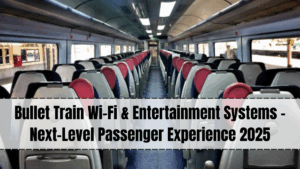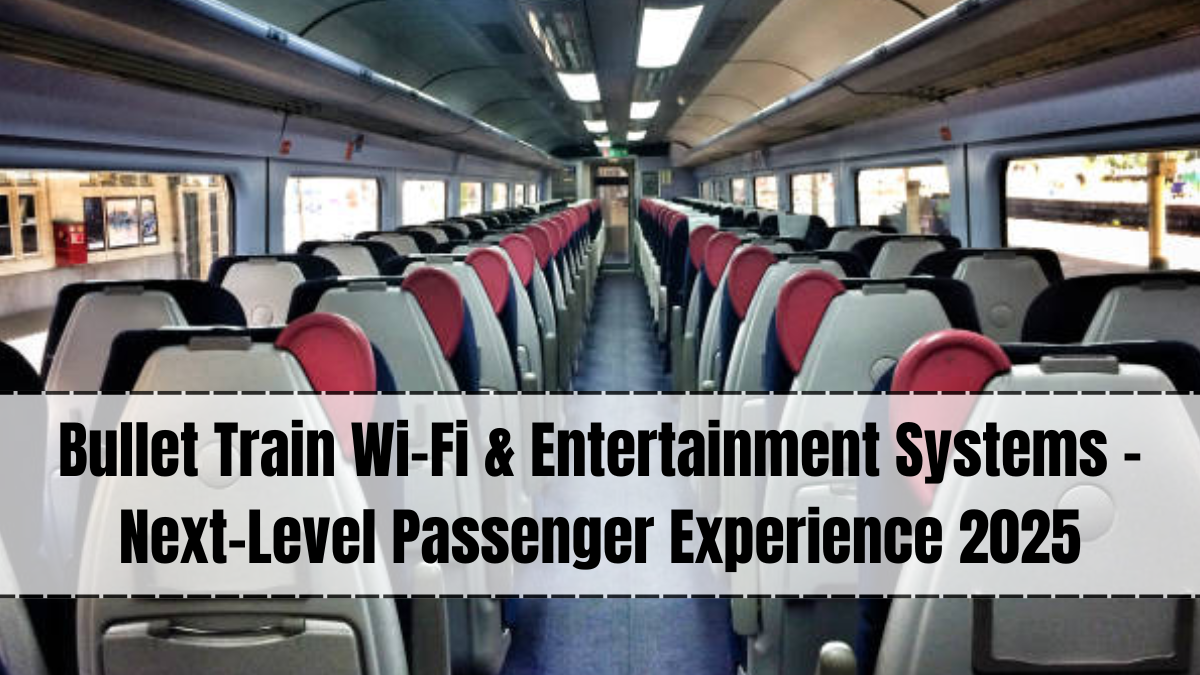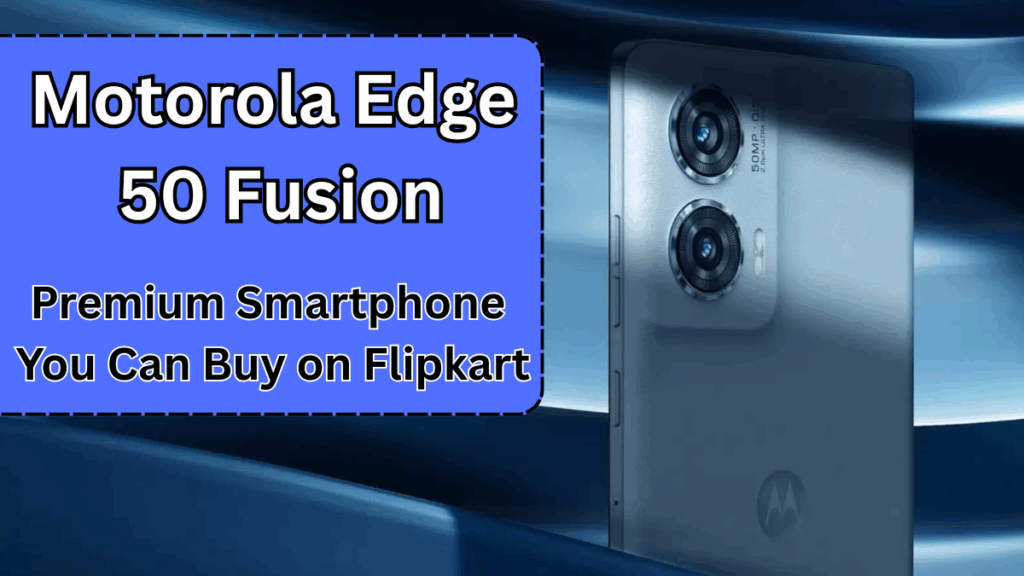In 2025, bullet trains are no longer just about speed. While their primary appeal has always been their ability to connect cities in record time, the latest generation of high-speed trains is equally focused on making every journey engaging, comfortable, and productive. The integration of high-speed Wi-Fi and advanced entertainment systems is transforming bullet train travel into a fully connected, immersive experience. Whether passengers are commuting for work or embarking on a leisure trip, they now enjoy uninterrupted streaming, interactive features, and personalized content while racing along at speeds exceeding 300 km/h.

Table of Contents
The Rise of High-Speed Rail Connectivity

For years, consistent internet access on high-speed trains was considered a challenge. At such rapid velocities, traditional mobile networks struggled with handovers between towers, resulting in frequent disconnections. In 2025, these issues have been largely solved through the combined use of 5G networks, dedicated railway communication infrastructure, and satellite internet systems. This triple-layered approach ensures passengers experience broadband-like speeds without interruption. The new systems allow for seamless video conferencing, live sports streaming, and cloud-based work, making bullet trains a practical alternative to short-haul flights for business travelers.
Technological Backbone of Bullet Train Wi-Fi
The success of high-speed rail Wi-Fi relies on multiple technological upgrades. First, 5G base stations are strategically positioned along the rail corridors to maintain line-of-sight connectivity. Second, trains are equipped with onboard signal boosters and routers capable of handling hundreds of simultaneous connections without compromising speed. Finally, satellite connectivity serves as a backup, ensuring service continuity in rural stretches or tunnels where ground-based signals are weak. Advanced AI-driven bandwidth management also prioritizes essential services such as emergency communications, while ensuring entertainment and casual browsing remain smooth.
Immersive Entertainment Systems for All Passengers
Beyond connectivity, bullet trains in 2025 are redefining onboard entertainment. Instead of the traditional single entertainment screen per seat, passengers now have access to personalized portals accessible through both seat-mounted touchscreens and their own devices. These platforms offer a wide range of content, from movies and TV shows to language-learning modules and curated travel guides. Families can enjoy child-friendly gaming zones, while solo travelers can stream podcasts, documentaries, and audiobooks. Some trains feature augmented reality windows that overlay live information about passing landscapes, offering a mix of education and sightseeing in real time.
Customization and Personalization of Content
The entertainment experience is now tailored to each passenger’s preferences. By logging in with a profile, passengers can pick up where they left off in a series, receive recommendations based on previous choices, and even switch seamlessly between devices. AI-powered systems analyze viewing and browsing habits to create personalized playlists, while multilingual support ensures travelers from different countries can enjoy content in their preferred language. This personalization extends to destination-based content, providing cultural insights, local news, and weather updates for the passenger’s arrival city.
Passenger Comfort and Productivity
The addition of reliable Wi-Fi and engaging entertainment systems has changed the way passengers use their travel time. Business travelers treat the journey as an extension of the office, making use of video conferencing tools, cloud storage access, and collaborative work platforms. Students can participate in online classes or research projects, while leisure travelers can enjoy streaming services or even take part in virtual reality experiences. This dual focus on work and play enhances passenger satisfaction and makes high-speed rail a strong competitor to air travel for trips under five hours.
Integration with Travel Ecosystems
Modern bullet trains are increasingly integrated into wider travel ecosystems. Passengers can book last-mile transport, hotel rooms, and local experiences through the onboard entertainment platform. Partnered tourism agencies offer exclusive discounts that can be redeemed directly during the journey. Real-time travel updates and ticketing integration also ensure smoother connections with other transport modes such as buses, metros, and domestic flights. This interconnected approach positions bullet trains as the centerpiece of a traveler’s entire journey rather than just one segment of it.
Challenges and Solutions
While the advancements in bullet train Wi-Fi and entertainment are impressive, challenges remain. High implementation costs, cybersecurity concerns, and the need for regular system upgrades require ongoing investment. Train operators are addressing these challenges through public-private partnerships, adopting subscription-based content models, and implementing strict encryption protocols to protect passenger data. Continuous feedback from travelers also helps operators fine-tune services and ensure they remain relevant and engaging.
Global and Indian Examples
Globally, Japan’s Shinkansen and France’s TGV have set benchmarks for high-speed train connectivity and entertainment, offering multi-language content libraries, real-time train data, and seamless internet access. In India, the upcoming Mumbai–Ahmedabad bullet train project is expected to incorporate similar systems, including dedicated streaming platforms and business-class cabins with enhanced connectivity. As adoption spreads, these features will likely become standard across high-speed rail projects worldwide.
Future of Bullet Train Passenger Experience
Looking ahead, bullet trains are expected to integrate even more advanced technologies such as holographic conferencing, AI travel assistants, and fully immersive VR entertainment pods. Biometric-based personalization could allow passengers to log into entertainment systems instantly, while predictive AI could suggest travel activities based on weather, local events, and personal interests. The goal is to make the journey as memorable and productive as the destination itself.
FAQs
How fast is bullet train Wi-Fi in 2025?
Most systems offer speeds between 150–250 Mbps, allowing seamless video streaming, gaming, and video conferencing.
Can I use my own devices for entertainment?
Yes. Most bullet trains allow you to connect personal devices to the onboard entertainment platform via secure Wi-Fi.
Is the onboard Wi-Fi free?
In many cases, yes for standard usage, though premium packages may be offered for higher speeds or data limits.
Will India’s bullet trains have these features?
Yes. The Mumbai–Ahmedabad bullet train project is expected to launch with high-speed Wi-Fi, streaming platforms, and multilingual content for passengers.
Click here to know more.






